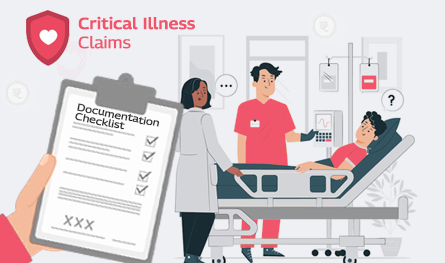Related Articles
 Jan 08, 2025
Jan 08, 2025
Is Varicose Vein surgery covered under the health insurance policy in India
 Health Insurance
Health Insurance


Critical illness insurance is a special secured health insurance protection cover that allows enhanced financial security in the event of treating several complicated ailments. Not all CI plans allow coverage for all sorts of critical ailments. The types of diseases covered remain mentioned in the policy documents.
Once the insured individual is diagnosed with any of the listed critical ailments, the insurer will offer a lump sum, depending on the sum insured amount, provided he/she outlives the designated survival period as per the plan terms.
Once this claim is settled, the plan automatically gets cancelled and becomes null and void.
The importance of CI insurance can never be exaggerated. However, you need to understand the claim settlement procedure to enjoy its complete benefits:
The critical illness claims settlement procedure is simple and user-friendly. You simply need to follow these few steps to complete the process:
To ensure smooth critical illness claims, you need to submit the following documents to your respective insurance provider:
While applying for critical illness claims settlement, you need to consider these aspects to negate the possibilities of claim rejection:
Young and healthy? Find out which of these plans rewards you with lower premiums. Click here to check now!

Paybima Team
Paybima is an Indian insurance aggregator on a mission to make insurance simple for people. Paybima is the Digital arm of the already established and trusted Mahindra Insurance Brokers Ltd., a reputed name in the insurance broking industry with 21 years of experience. Paybima promises you the easy-to-access online platform to buy insurance policies, and also extend their unrelented assistance with all your policy related queries and services.

.png)
Accidents can happen anywhere, anytime, by your own fault or another person. What’s important is to be prepared for such mishaps. This is where Own Damage Car Insurance comes in handy.

.png)
The no claim bonus (NCB) in bike insurance is a very handy benefit that allows you to save money on your overall motor insurance costs. The bike insurance provider rewards you for not making a claim by offering a discount on the premium of the following year.

.png)
When it comes to medical emergencies, the last thing you want to worry about is arranging money for hospital bills. That’s where a health insurance claim comes in handy. Health insurance allows you to either get your expenses reimbursed later or, in many cases, get treated without paying upfront through a cashless facility.

.png)
Health insurance plans often come with terms that sound like they belong in a secret financial club. One such term is “co-pay.” You might have seen it in your policy document and quietly ignored it, hoping it won’t matter until you actually need to claim. But here’s the twist: co-pay can directly affect how much premium you pay each year.
